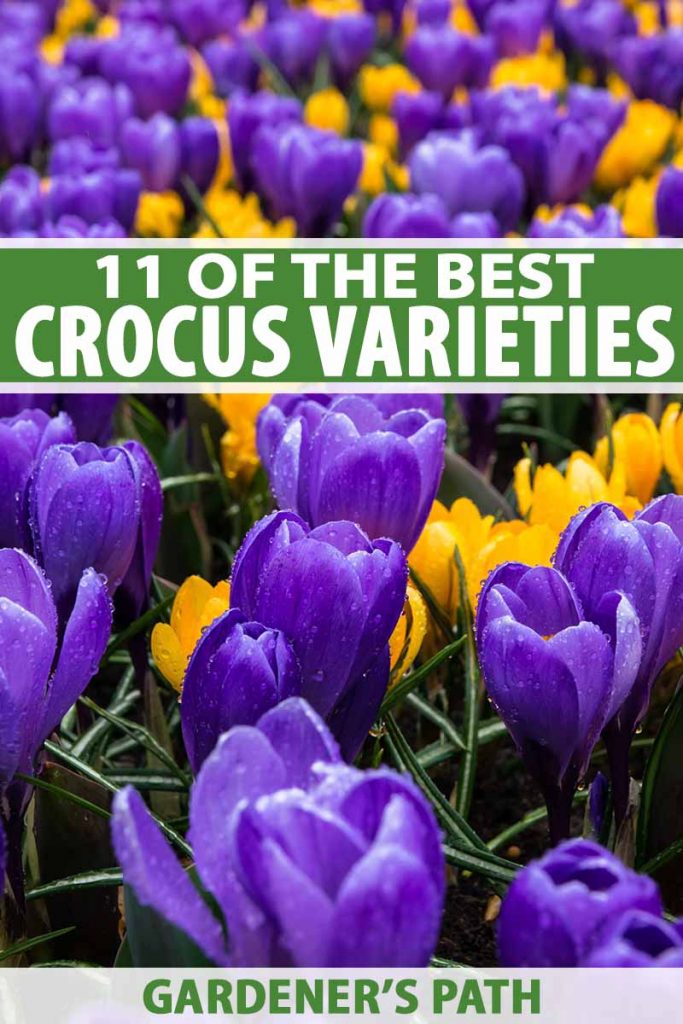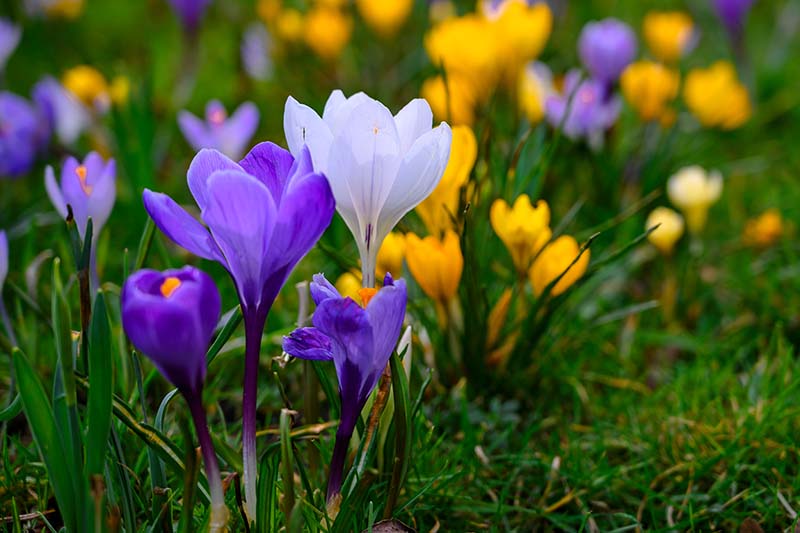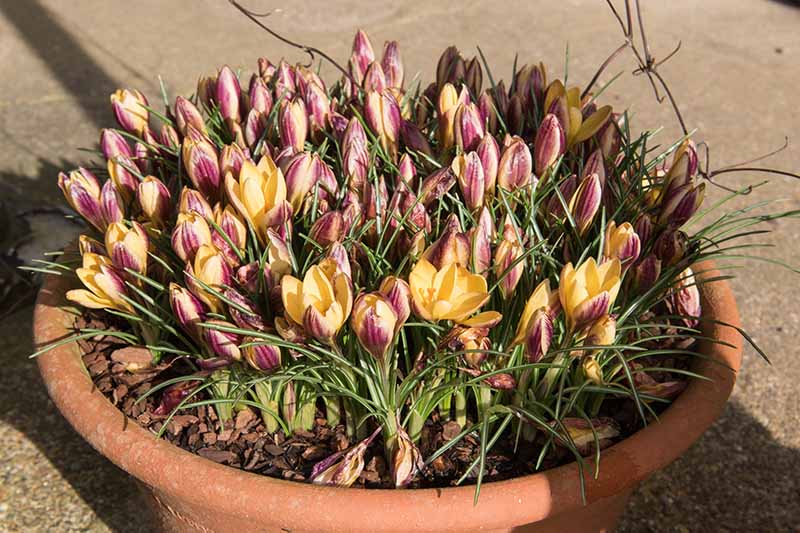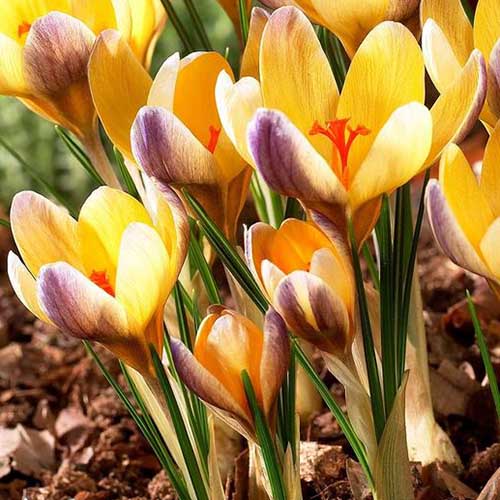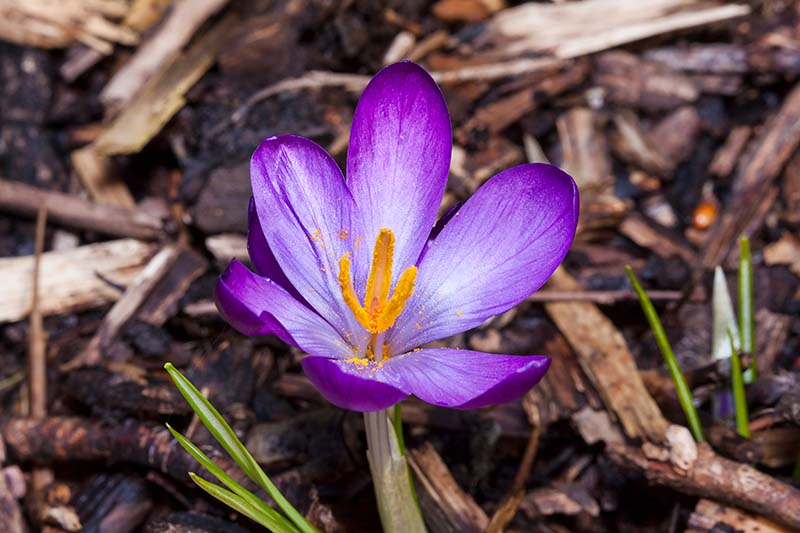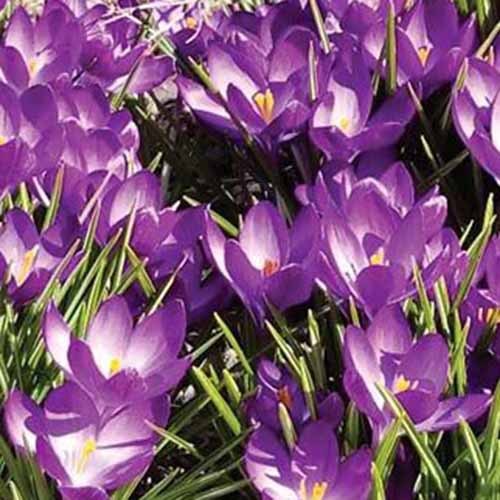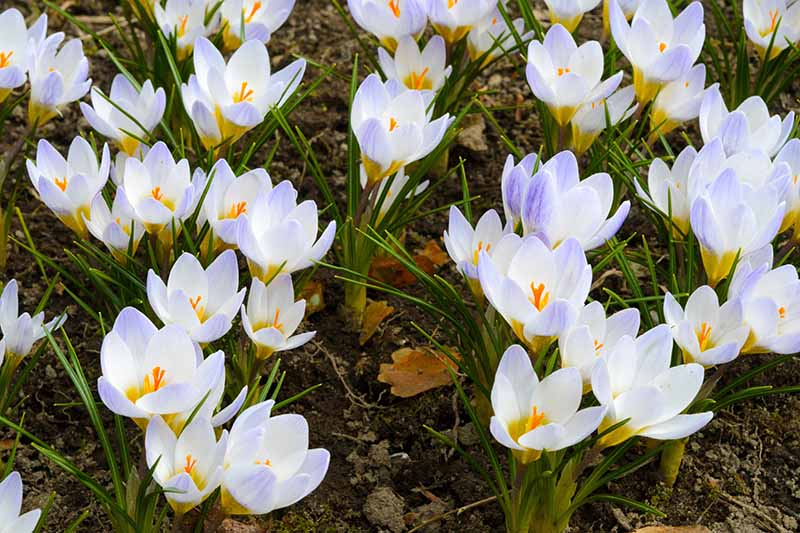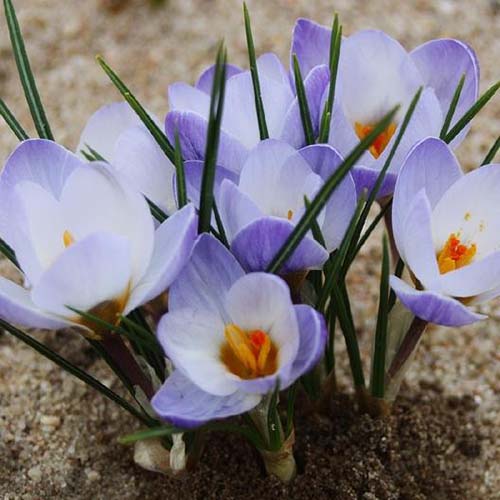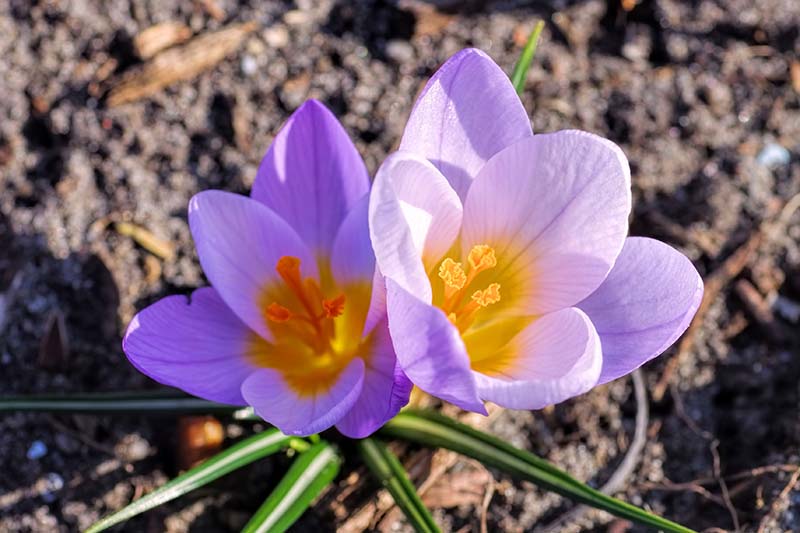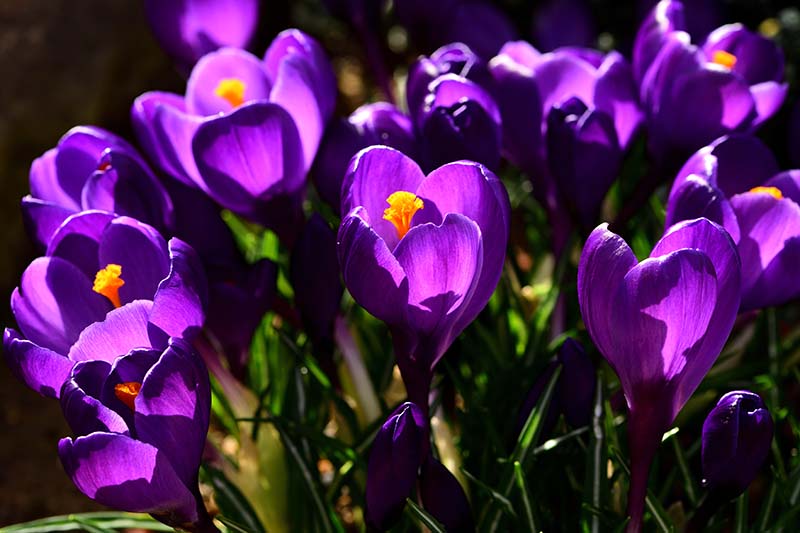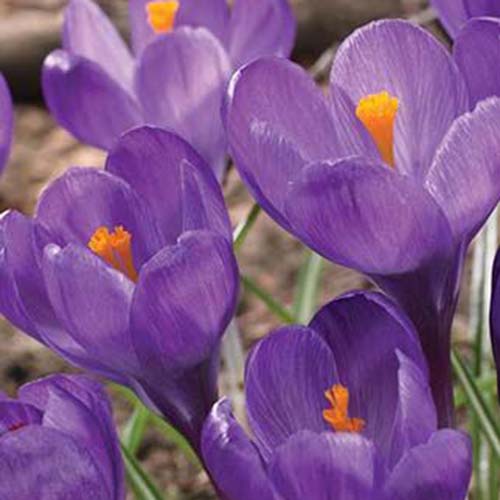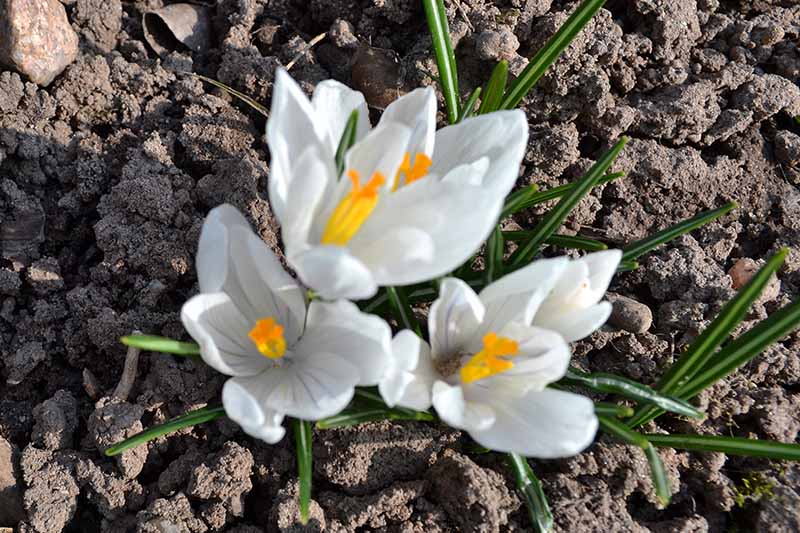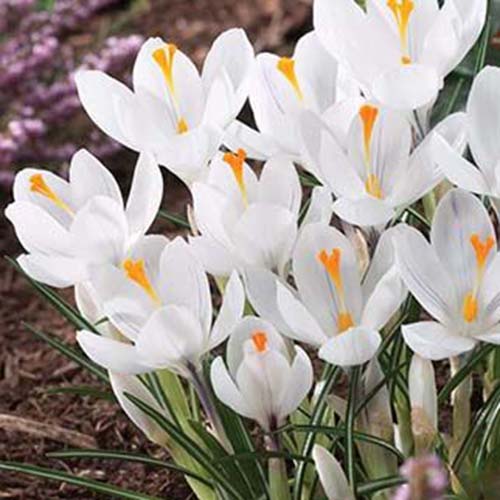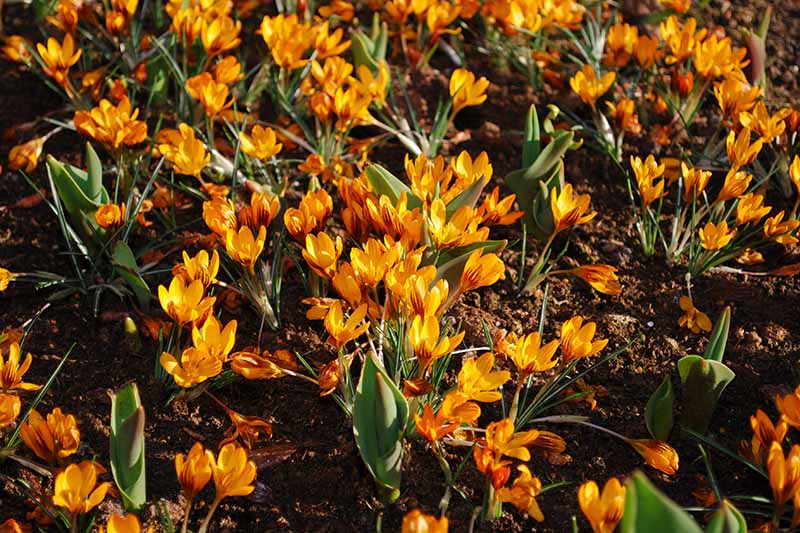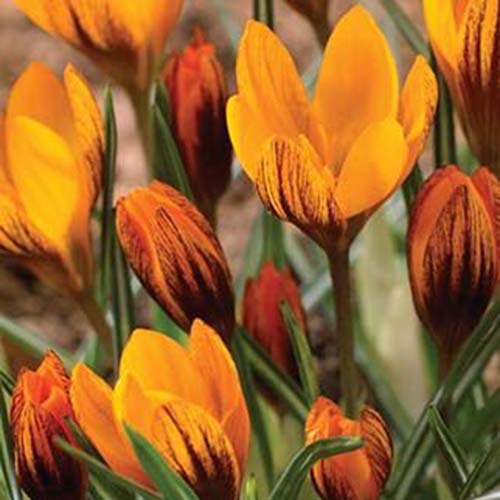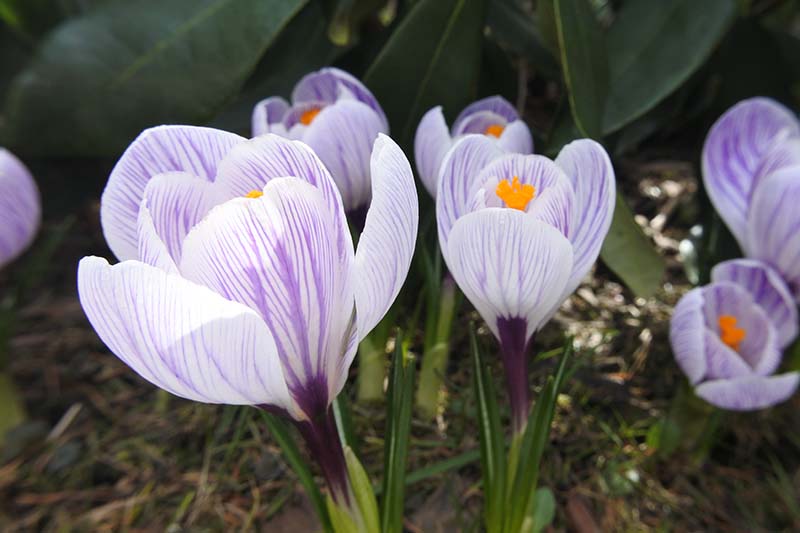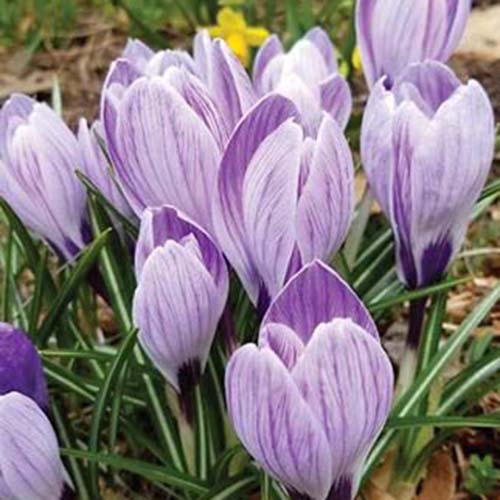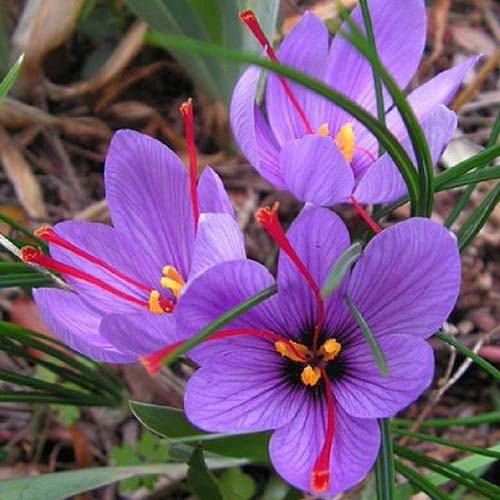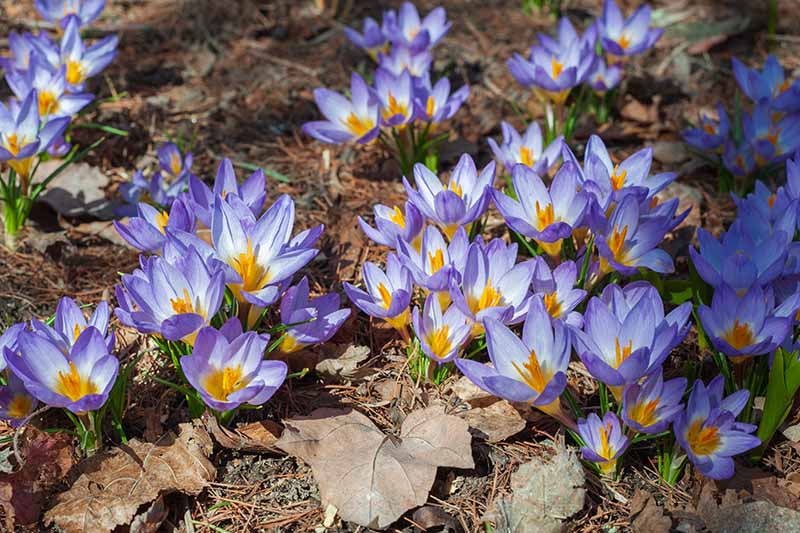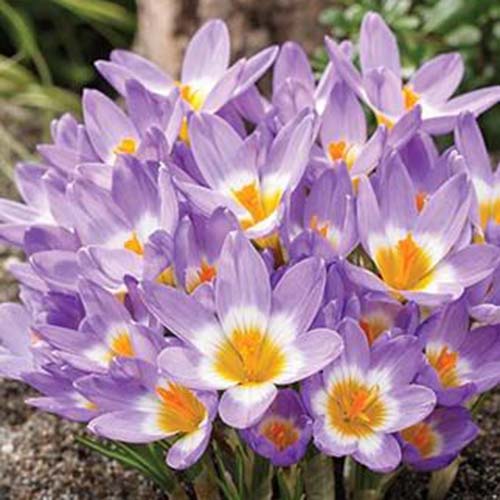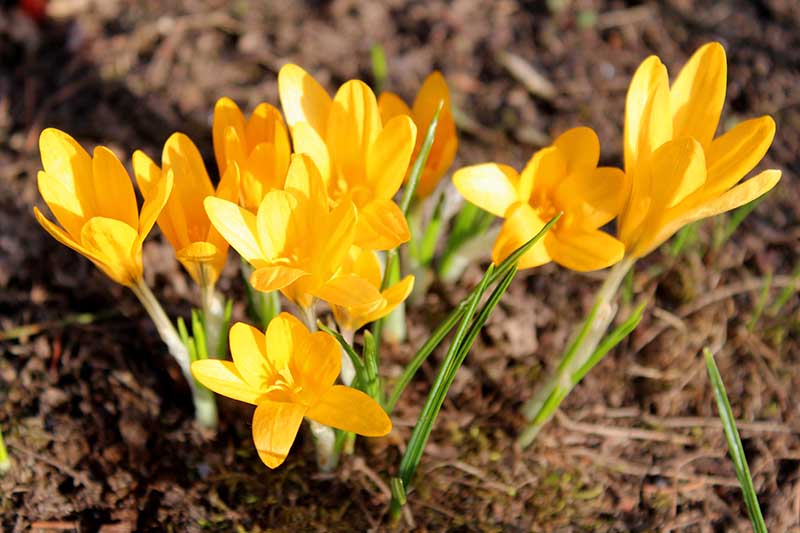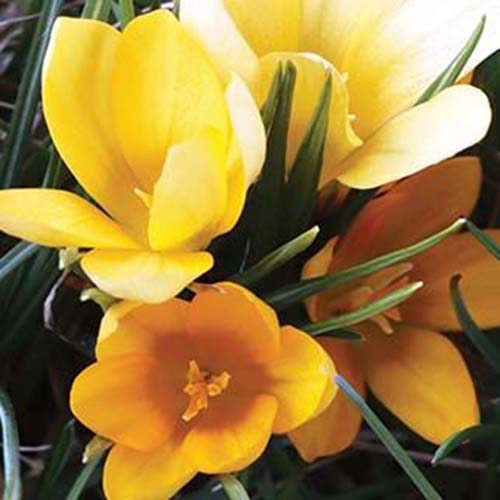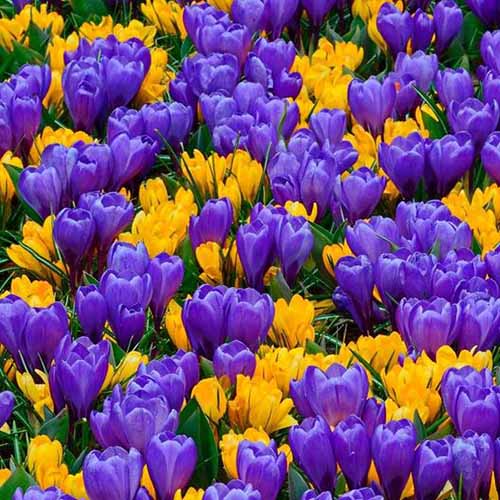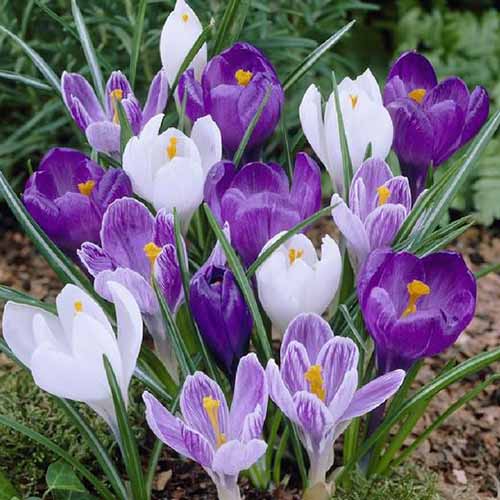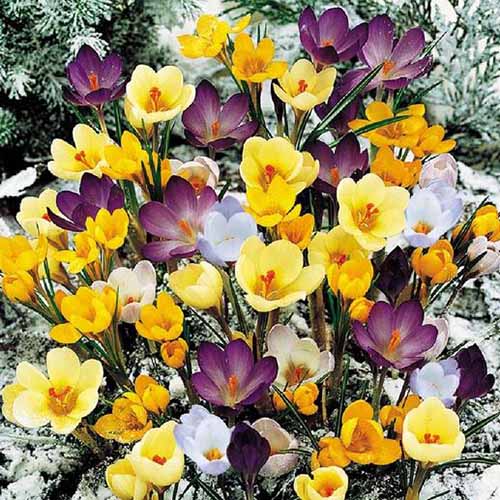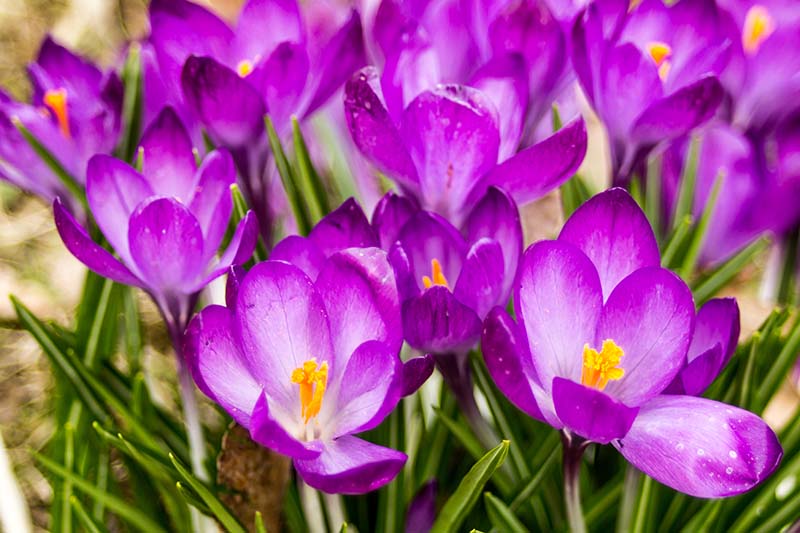While it’s all very charming and beautiful, I start aching for color in February. So I usually run to the grocery store and pick up some candles that smell like spring – and flowers that look like it. But what if in addition to my stunning store bought flowers, I had crocuses growing in my garden to gaze at, too? We link to vendors to help you find relevant products. If you buy from one of our links, we may earn a commission. So because I’ve been looking for varieties to plant in the fall, I’ve rounded up the 11 best varieties for your yard or garden.
If you find you can’t decide between them, why not get a mix of bulbs? There’s three options for those, too.
Quick Primer on Different Species
You’ll notice that while all the blooms below are all of the same genus, Crocus, in the iris family, Iridaceae, not all are the same species.
Crocus chrysanthus, also called “snow crocus” because it tends to bloom at least two weeks before others in the same genus.
C. tommasinianus, known also as “Tommasini’s crocus,” is named in honor of the long-ago mayor of Trieste, Italy (then part of the Austro-Hungarian Empire), Muzio G. Spirito de Tommasini. He also happened to be a botanist. You may hear this species referred to as “woodland crocus” or even simply “tommies.”
C. vernus, which is sometimes known as “Dutch crocus” is native to the Pyrenees, Balkans, and Alps and is grown prolifically in – you guessed it – Holland. This species is larger and two weeks later to bloom than C. crysanthus.
C. sativus, the saffron crocus, also called “autumn crocus” because it blooms in the fall, as opposed to the late winter and early spring flowering of other species. This is the species used to produce the spice saffron. Not to be confused with Colchicum autumnale, a different flower in Colchicaceae family that is also known as “autumn crocus.”
C. sieberi, a small, early bloomer that grows wild on the Greek island of Crete. For this reason, it’s often referred to as the Cretan crocus.
Now, let’s get started on finding the perfect bulbs for your garden.
1. Advance
C. chrysanthus Don’t be fooled by the boring name, because the ‘Advance’ crocus variety is anything but. Delicate yellow with strokes of purple and cream, these blooms earn their name by being one of the very earliest of the early bloomers.
The delicate flowers only reach up to three inches tall. They’re hardy in USDA Hardiness Zones 3-8, love sunshine, and are drought tolerant, making them a practically worry-free flower.
‘Advance’ Since my house is dark red, I might just plant ‘Advance’ in my front lawn for a nice color contrast. This is easy to do with bags of 50, 100, or 250 bulbs available at Eden Brothers, that ship in the fall.
2. Barr’s Purple
C. tommasinianus A slender-necked, purple flower, the ‘Barr’s Purple’ crocus opens into a pleasing bowl shape, as though it’s welcoming a pool of sunshine to fill its petals.
This deer-resistant bloom grows best in Zones 4-8, flowers in late February and early March, and reaches a height of four to six inches.
‘Barr’s Purple’ You can get bags of 15 bulbs that ship in late summer from Burpee.
3. Blue Pearl
C. chrysanthus As its name suggests, the ‘Blue Pearl’ crocus variety features light pearly-blue petals and is downright lovely.
For those who prefer a softer color instead of something bold and bright, ‘Blue Pearl’ is the answer. How neat would it be to see these demure flowers bloom every March or April? Combine with a white or yellow-flowering variety for an extra burst of color.
‘Blue Pearl’ These corms, which grow best in USDA Zones 3-8, were hybridized in Holland over fifty years ago. They’re smaller than true Dutch crocus varieties and bloom earlier, but pairing the two types of bulbs together gives your garden a radiant, natural look. Find them in packs of 50, 100, and 200 bulbs that ship in the fall, available at Eden Brothers.
4. Firefly
C. sieberi A variety of C. sieberi, ‘Firefly’ features pale violet flowers with golden throats.
Even better? They’re deer resistant, so planting them with a non-deer-resistant variety means protection for all your precious corms. ‘Firefly’ For a field of sweet ‘Firefly’ blooms, plant groups of nine or ten corms every square foot. Create patches of crocuses like this all over your lawn for a natural, meadow-like look.
5. Flower Record
C. vernus For deep purple blooms that could probably be seen from space, try ‘Flower Record,’ with its delicate rounded petals and vibrant color.
This Dutch variety grows large blooms and flowers in March and April, depending on the climate.
‘Flower Record’ ‘Flower Record’ grows in USDA Hardiness Zones 3-9 and reaches heights of four to six inches, making it a perfect spring flower for almost anyone. Bags of 15 bulbs are available from Burpee and ship during the late summer and early fall.
6. Jeanne d’Arc
C. vernus Courageous as its namesake, the ‘Jeanne d’Arc’ crocus is snow-white and extra hardy, thriving in Zones 3-9.
Plant this Dutch variety by herself for a stunning field of pale blooms, or combine with ‘Pickwick,’ described below, for a pleasing color combination.
‘Jeanne d’Arc’ This bloom reaches four to six inches in height and bags of 15 bulbs are available at Burpee.
7. Orange Monarch
C. chrysanthus Do you dream of seeing a kaleidoscope of monarch butterflies alighting on pink tufts of milkweed? The ‘Orange Monarch’ crocus may be as close as you’ll get. And in your own garden, too!
These vibrant blooms thrive in USDA Hardiness Zones 3-7, so they’re perfect for those of us who live in chillier states.
‘Orange Monarch’ But like all crocuses, they adore the sun, so make sure to plant them in a bright location. Plant in groups of 20-50 corms for a spectacular spring show. Packs of 15 bulbs are available at Burpee.
8. Pickwick
C. vernus With sturdy blooms and a name reminiscent of the March sisters’ plucky Pickwick Club in Louisa May Alcott’s Little Women, ‘Pickwick’ features lavender petals with delicate purple stripes running vertically up each bloom.
Plant in the fall in Zones 3-9 for a gorgeous spring lawn. These blooms reach up to six inches tall.
‘Pickwick’ These would look lovely in my backyard and remind me of my literary heroines to boot. Since they’re not deer-resistant, I’ll have to plant them alongside ‘Barr’s Purple’ or ‘Firefly’ to keep my resident moose away! Find bags of 15 bulbs that ship in the fall from Burpee.
9. Saffron Crocus
C. sativus Do you enjoy using the spice, saffron, in everything from cakes to curries? Then you’ll love this bright purple, fall-blooming saffron crocus.
Preferring USDA Hardiness Zones 6-9, this variety grows long red stigmas that you can harvest and lay out to dry in a warm room. There aren’t different cultivars available for the home gardener of this species like there are of, say, C. crysanthus. This is due to the plant mainly being grown commercially as a spice, and because C. sativus is an entirely hybridized plant. That said, each country that grows saffron commercially has its own cultivar: ‘Aquila’ in Italy, ‘Creme’ in Spain, and ‘Lacha’ in Kashmir.
C. sativus Just about all saffron crocuses that you find in nurseries won’t say what cultivar it is. But they all get planted in late summer and will bloom in the fall. The delicate purple flowers grow up to four inches tall. Find packages of 10, 20, 50, or 100 bulbs that ship in late summer, in time for planting, from Eden Brothers. Once planted, these spicy beauties flower in just six to eight weeks. And voila, as well as enjoying the vibrant colors, you’ve grown your own saffron!
10. Tricolor
C. sieberi One of the very first crocuses to bloom in the springtime, ‘Tricolor’ boasts violet petals with white and yellow throats.
This bloom favors Zones 4-8 and is likely to push up through late-February snows.
‘Tricolor’ Like all its crocus siblings, the ‘Tricolor’ crocus enjoys full sun or part shade and grows to a height of four to six inches. Find bags of 15 bulbs during the summer months, available at Burpee.
11. Yellow Mammoth
C. vernus ‘Yellow Mammoth’ crocuses will make your backyard look like a pool of sunshine – just when you need it the most. Even better, this variety is deer resistant, so you don’t have to worry about backyard creatures munching on your sunshine before you can enjoy it yourself.
In Zones 3-9, plant these bulbs in the fall for an early-spring display. They love sunlight or part-shade, so make sure to plant them in an open area or at the edge of a knot of trees for a wild, natural look.
‘Yellow Mammoth’ Growing four to six inches tall, ‘Yellow Mammoth’ is one of the larger varieties. Plant with hellebores for a truly stunning spring display. You can buy a package of 15 bulbs that ship in the fall, from Burpee.
Mixed Cultivars
If, like me, you can’t decide which of the varieties described above will make it into your garden this year, why not try a mix? Here are three of my favorites that you can add to your landscape for a delightful array of colors, come springtime.
1. Blue and Yellow Mix
C. Vernus For an extra cold-hardy, extra colorful early-spring carpet of color, plant this blue and yellow mix in Zones 3-8. These flowers will grow up to six inches tall and are drought tolerant, so if you live in a drier climate, they’re ideal.
Blue and Yellow Mix Like other Dutch varieties, these bloom in March or April, depending on your Zone. Find bags of 50, 100, and 250 bulbs available from Eden Brothers.
2. Blue Moon Mix
C. Vernus Another Dutch crocus mix, this white, light purple, and darker purple large-flowering blend of bulbs makes it easy to mix up the colors in your garden.
Blue Moon Mix Growing best in Zones 3-8, you can plant these bulbs in the fall for a March or April show that’s reminiscent of a moonlit sky. Find bags of 50, 100, and 250 bulbs through Eden Brothers.
3. Specie Mix
C. Chrysanthus Though featuring another somewhat drab name for a far-from-drab mix of blooms, this mix of C. chrysanthus bulbs is one of the prettiest blends of blooms out there. And it flowers two weeks earlier than C. vernus. Combine both in your garden for at least a month of continuous blooming: first, two to three weeks of your C. chrysanthus flowers. Just when those are beginning to die back, your C. vernus bulbs will flower.
Specie Mix With deep purple, white, light violet, dark yellow, and light yellow snow crocus blooms all combined, you’re sure to feel jubilant when these pop out in your spring garden. Grow them in Zones 3-8 and expect them to reach heights of four to six inches tall. You can get find of 50, 100, and 250 bulbs available from Eden Brothers.
A Crocus for Everyone
As you can see, there’s a color and bloom available to just about everyone who hopes to grow crocuses in their spring garden. If you like one variety this year, try adding a complementary color to your garden the next. And don’t forget that most crocus varieties love to multiply over time, providing you with an endless feast of early-spring color.
Even if you live somewhere crocuses don’t thrive outdoors, you can easily force bulbs indoors. Have you grown crocuses in your garden? What’s your favorite variety? We’d love to know in the comments below. And don’t forget to check out our other articles on growing crocus flowers:
When to Plant Crocus Bulbs 9 Reasons Your Crocus May Not Bloom Can Crocus Grow in the Cold and Snow?
